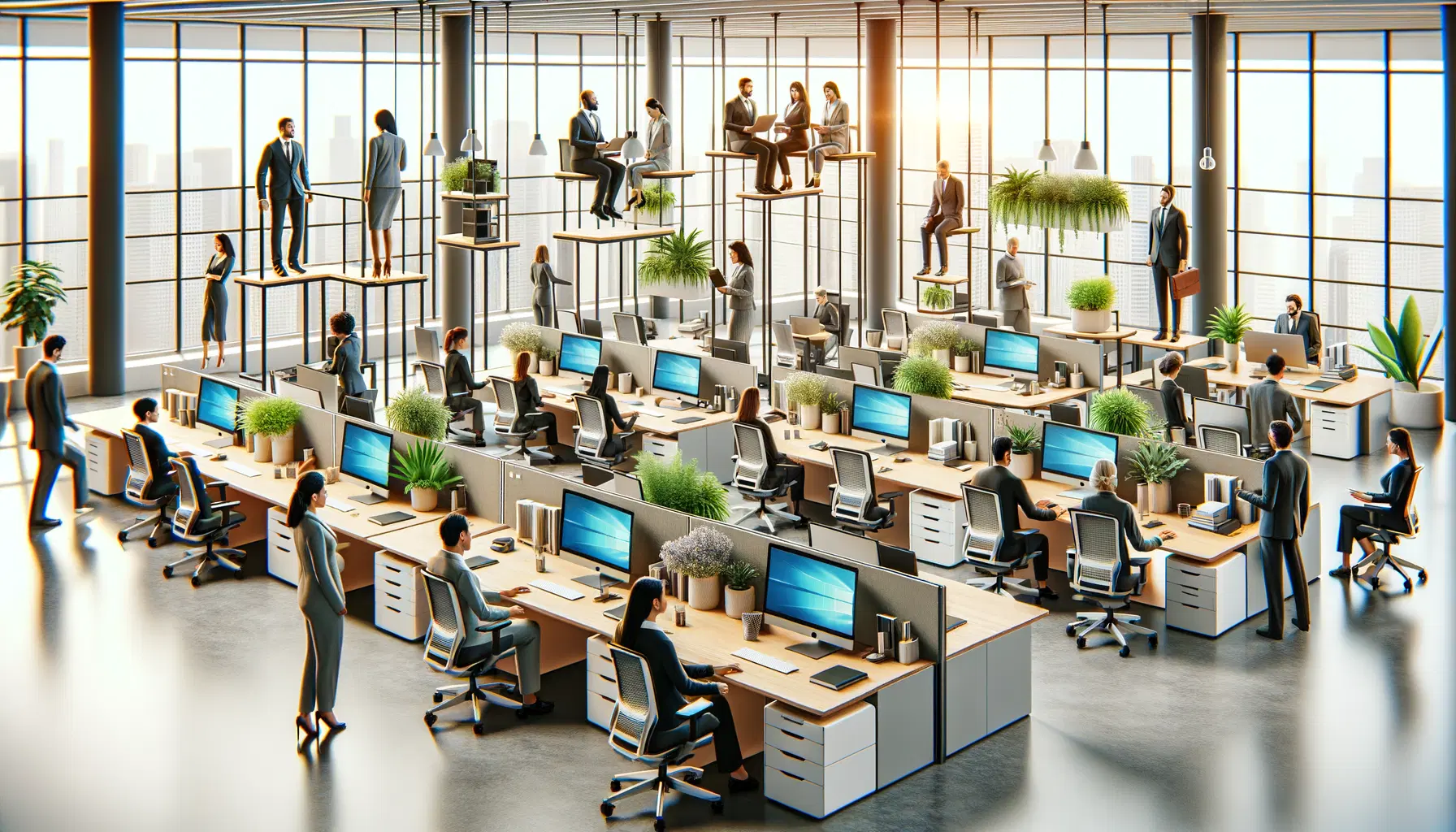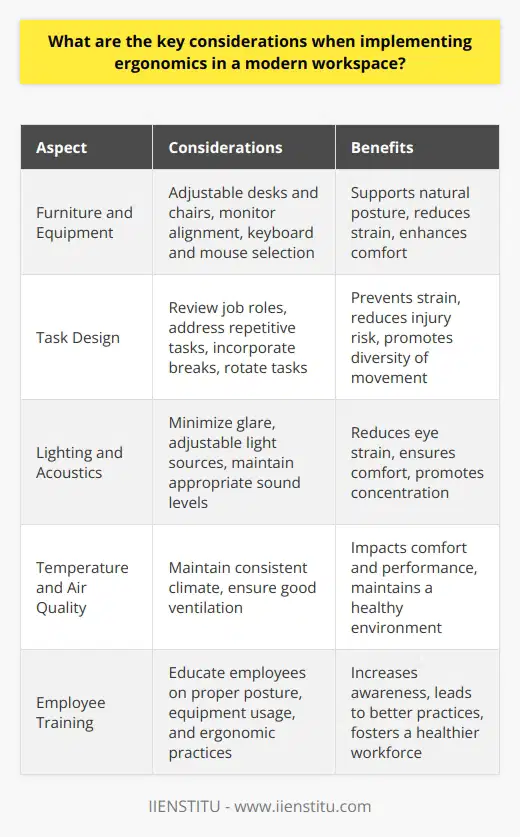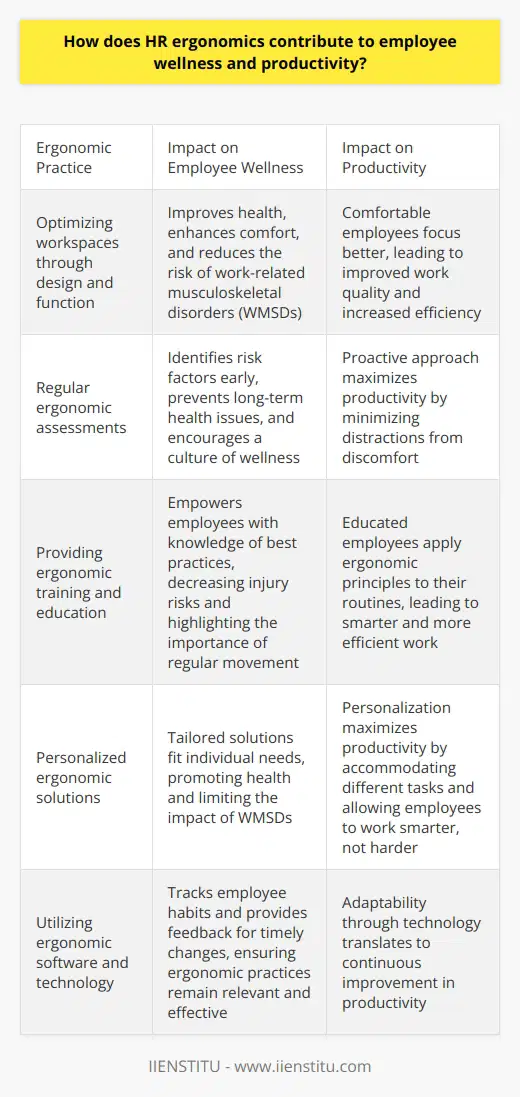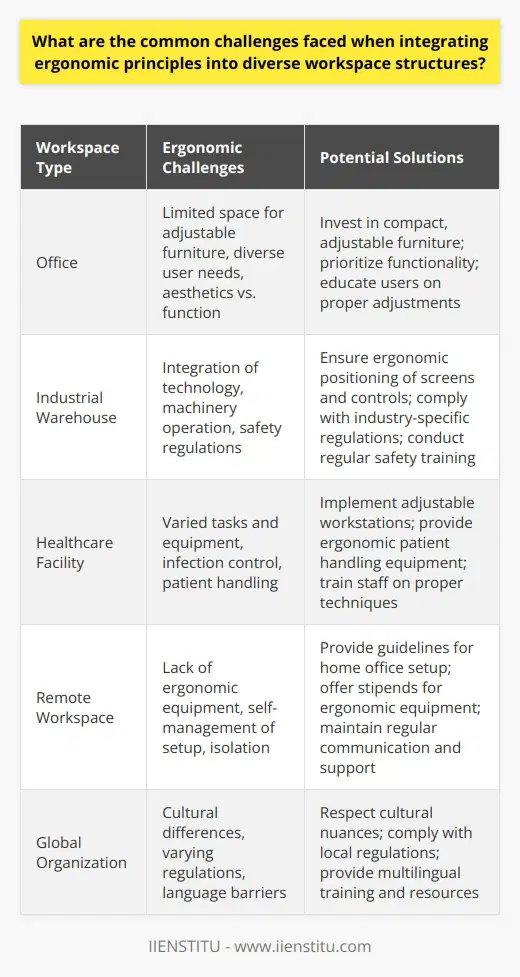
In the contemporary world of human resource management, the integration of ergonomic principles has become a paramount aspect of creating a conducive work environment. The concept of ergonomics, often overlooked in the past, is now recognized as a critical component in designing workspace infrastructures that enhance employee well-being and overall organizational productivity.
This article delves into an in-depth discussion on HR ergonomics, examining its foundational principles, application in modern workplaces, and the future outlook as it interfaces with advancing technologies and sustainability trends. Drawing from a wealth of academic sources and real-world applications, this piece aims to provide HR professionals and organizational leaders with a comprehensive understanding of the significance of ergonomics within the HR scope and present actionable insights for its implementation.
Effective Human Resources Management Strategies To Maximize Hr Team Potential
What İs Human Resource Management And İts İmportance İn Organizations
Introduction to HR Ergonomics
Definition and Overview of Ergonomics
Ergonomics is the scientific discipline concerned with understanding human interactions within their environment, particularly in the context of their work spaces. It seeks to optimize these interactions to preserve health, enhance performance, and ensure comfort.
Intertwined with the human resources department, ergonomics becomes a strategic tool in employee management — balancing individual physical capabilities with the demands of their roles. This approach not only focuses on equipment and furniture design but also considers organizational policies, work processes, and the overall work culture.
Importance and Benefits of Ergonomic in Human Resources
Within the HR domain, ergonomics surfaces as a pivotal factor in fostering a productive and healthy workforce. It is not merely about providing comfortable office chairs but encompasses a broader spectrum involving the design of tasks, workstations, and the work environment to complement the strengths and limitations of the human body.
The application of ergonomic standards within human resources has been shown to considerably mitigate work-related musculoskeletal disorders, reduce absenteeism, enhance employee engagement, and subsequently, drive organizational success. HR certification programs increasingly incorporate ergonomics training, acknowledging its significance in comprehensive HR education.
Purpose of the Blog: Exploring HR Ergonomics
The objective of this blog is to explore the multifaceted nature of HR ergonomics. Through a thorough examination of its application in workplace design, the role of ergonomic training, and the formulation of conducive policies, readers will gain a deeper insight into how ergonomics underpins the tenets of progressive HR practices.
As companies strive for operational excellence, the interweaving of HR initiatives with ergonomic principles stands as a testament to their commitment to employee well-being and corporate stewardship.
Understanding the Role of Ergonomics in HR Practices
Link between Ergonomics and Workplace Efficiency
The correlation between well-conceived ergonomic environments and workplace efficiency is compelling. Ergonomic principles, when applied judiciously, lead to the design of workspaces that not only minimize injury risk but also optimize user comfort and task efficiency.
Detailed analysis yields that appropriately adjusted workstations, supportive seating, and thoughtfully arranged tools significantly alleviate physical strain and mental fatigue. Concrete examples, such as the implementation of adjustable desks and the strategic placement of computer monitors, have been tied to improved productivity, depicting ergonomics as a facilitator of enhanced performance.
The correlation between Ergonomics and Employee Health
Ergonomics is inextricably linked to employee health, with its influence permeating various aspects of workplace well-being. By focusing on the best ergonomic practices, HR can play a pivotal role in preventing chronic workplace injuries, such as repetitive strain injuries or back problems.
Discussing health benefits, it becomes apparent that correct postural alignment facilitated by ergonomic interventions can lead to a reduction in complaints of discomfort and long-term health issues. Examples of common health problems associated with poor ergonomics include carpal tunnel syndrome and chronic back pain, both of which can be significantly reduced with proper ergonomic practices.
Key Aspects of HR Ergonomics
Workstation Design and Ergonomic Assessments
When it comes to the aspect of workstation design, ergonomics dictates that a deep understanding of the interplay between a worker's physical dimensions and the workspace is essential. The importance of ergonomic workstation design is underscored by its impact on the employee's comfort and productivity.
Conducting ergonomic assessments with the participation of HR professionals allows for the identification of potential improvements in workstation setup, ensuring that each aspect of the workspace is conducive to maintaining the health and efficiency of the workforce.
Ergonomic Training and Employee Education
The responsibility of HR in providing ergonomic training is paramount in cultivating a culture of health and safety within an organization. By facilitating comprehensive ergonomic training, HR departments ensure that employees are well-versed in the practices that promote proper body mechanics and workspace utilization.
Examples of successful training initiatives include interactive workshops, engaging e-learning modules, and on-site coaching—all aimed at instilling ergonomic awareness and fostering a proactive approach to one's work environment.
Policies for an Ergonomically-friendly Work Environment
To establish a truly ergonomically-friendly work environment, it is imperative that HR professionals advocate for and implement policies reflecting the organization's commitment to employee well-being. Essential ergonomics-related policies might involve regular ergonomic assessments, provisions for ergonomic furniture, and scheduled breaks to alleviate physical and mental strain.
Case studies across various industry sectors demonstrate that enacting ergonomic policies has a profound impact on reducing workplace injuries, enhancing employee morale, and increasing overall job satisfaction.
The Future of HR Ergonomics
Technological advancements and Ergonomics
As we look toward the future, the influence of technological advancements on HR ergonomics becomes an exciting prospect. From artificial intelligence (AI) aiding in ergonomic analysis to virtual reality (VR) simulations for ergonomic training, tech innovations are poised to transform traditional ergonomic practices.
Discussing how these technologies reshape HR ergonomics, it's crucial to weigh not only the benefits they bring but also the potential challenges in implementation, accessibility, and adaptation across different workforce demographics.
The role of Sustainability in HR Ergonomics
Sustainability and ergonomics, two seemingly distinct concepts, are increasingly converging within the HR framework. With a growing emphasis on creating sustainable work environments, ergonomic considerations are being integrated into company policies and practices, advocating for the responsible use of resources while ensuring employee well-being.
Examples are emerging of progressive businesses that have successfully amalgamated sustainability with ergonomics, leading to workspaces that are health-conscious, environmentally friendly, and economically beneficial.
Summarizing the Importance of Ergonomics in HR
This exploration of HR ergonomics culminates in the unequivocal conclusion that ergonomic considerations are fundamental to the success of contemporary HR practices. The impact of ergonomics is felt, not only in the direct enhancement of employee well-being but also in the broader context of organizational health and competitive advantage. As such, the integration of ergonomic principles should be regarded as an essential component in the HR toolkit.
Encouragement for HR practitioners and organizations to adopt ergonomic practices
With the insights presented, it is the fervent hope that HR practitioners and organizational leaders will be encouraged to embrace and prioritize ergonomic practices.
Through dedicated measures such as certificate courses online in ergonomics, companies can foster an environment where employee well-being is a core value, consequently enhancing organizational resilience and fostering a culture of perpetual growth.
Final notes on the continuous evolution of HR ergonomics and its potential for the future
As we close this discussion, it is important to recognize that HR ergonomics is not a static field but one that continuously evolves with technological advancements, workplace trends, and societal changes. The potential for the future of HR ergonomics is vast, offering a canvas for innovative and empathetic solutions that align with an organization's vision for a human-centric, high-performing workplace.
The journey of integrating ergonomic excellence into HR practices is both a challenge and an opportunity—a venture that is sure to reward organizations with a profound and lasting impact on their most valuable asset, their people.
Frequently Asked Questions
What are the key considerations when implementing ergonomics in a modern workspace?
Ergonomics in the Modern Workspace
Understanding Ergonomics
Ergonomics focuses on designing workspaces. It aligns with user needs. The goal is reducing strain. And enhancing productivity. Optimal design is essential. It considers user interaction with the environment.
Assessing Needs
One starts with a thorough assessment. This analysis includes employee activities. It also looks at workspace layouts. Equipment use is another aspect. Such assessments identify potential problem areas. They inform the design process.
Furniture and Equipment
Choosing the right furniture is key. Desks and chairs must adjust to users. They support natural posture. Equipment like monitors matters too. They should align with eye level. Keyboards and mice require careful selection. They should promote a neutral hand position.
Task Design
One must consider task design. This involves reviewing job roles. Repetitive tasks need attention. Breaks are essential. They prevent strain. Employees should rotate tasks. This diversity of movement reduces injury risk.
Lighting and Acoustics
Lighting should minimize glare. It reduces eye strain. The source must be adjustable. This ensures comfort in varying conditions. Acoustics play a role too. Sound levels should not be distracting. They should promote concentration.
Temperature and Air Quality
Temperature impacts comfort. It affects performance. The workspace needs a consistent climate. Humans prefer a moderate temperature. Air quality also deserves consideration. Good ventilation is crucial. It maintains a healthy environment.
Employee Training
Training is pivotal. Employees must understand ergonomics. They learn about proper posture. They also discover how to use equipment correctly. Awareness is instrumental. It leads to better practices.
Continuous Improvement
Ergonomics is not static. Workplaces evolve. Workers change. Regular reviews are necessary. They ensure the workspace adapts. They address the emergence of new challenges. Feedback from employees is valuable. It offers insights for improvement.
In conclusion, ergonomics is a multidisciplinary approach. It requires commitment. Workspaces must support health. They must augment efficiency. These considerations foster a better workplace. They benefit the workforce. And they positively influence productivity.

How does HR ergonomics contribute to employee wellness and productivity?
HR Ergonomics Enhances Employee Wellness
Understanding Ergonomics
Ergonomics involves optimizing workspaces. It combines design and function. HR focuses on employee well-being. Proper ergonomics improve health. It also enhances comfort. Workstations become more user-friendly. Employees suffer fewer injuries.
Ergonomics and Employee Wellness
Work-related musculoskeletal disorders (WMSDs) are common. They result from poor ergonomic practices. Good ergonomics reduces these risks. Employees enjoy better health. They feel less stressed. Less pain equals higher job satisfaction. HR ensures ergonomic strategies align with employee needs. This attentiveness boosts overall wellness.
Regular Ergonomic Assessments Matter
HR conducts ergonomic assessments. These identify risk factors early. HR provides recommendations. Adjustments happen promptly. This prevents long-term health issues. It encourages a culture of wellness. Proactivity is key.
Training and Education Equip Employees
Knowledge empowers workers. HR provides ergonomic training. Employees learn best practices. They apply these to their routines. This decreases injury risks. Education highlights the significance of breaks. Regular movement is vital for health.
Ergonomics and Productivity
Productivity links closely to ergonomics. Comfortable employees focus better. Distractions from discomfort diminish. Work quality improves. Efficiency increases.
Tailored Ergonomic Solutions Foster Efficiency
HR personalizes ergonomic solutions. They fit individual needs. Personalization maximizes productivity. Workplaces accommodate different tasks. Employees work smarter, not harder.
Technology Assists Ergonomic Implementation
Ergonomic software helps HR. It tracks employee habits. Feedback allows timely changes. Adaptability translates to continuous improvement. Technology ensures ergonomic practices stay relevant.
HR ergonomics supports wellness and productivity. HR plays a pivotal role. They ensure work environments promote health. They limit the impact of WMSDs. Regular assessments and training are essential. Personalized ergonomic solutions boost efficiency. Technology aids in maintaining effective practices. Employees benefit from a well-executed ergonomic strategy. Both employee wellness and productivity see significant gains.

What are the common challenges faced when integrating ergonomic principles into diverse workspace structures?
Understanding the Ergonomic Challenge
Ergonomics aims to adapt workspaces to users' needs. It focuses on improving comfort, efficiency, and safety. Yet, integrating ergonomic principles into diverse workspaces presents certain challenges. These spaces range from offices to industrial warehouses. Each requires tailored ergonomic solutions.
Diverse User Needs
Workspaces serve users with different roles. These roles dictate distinct tasks and equipment. An ergonomic solution effective for one user may not suit another. It requires careful assessment to determine the appropriate ergonomic interventions.
Workers also vary in physical dimensions and capabilities. Ergonomic designs must cater to this range of human attributes. Adjustable furniture is essential. It ensures that a workspace can serve various body types and sizes. Still, such furniture might be expensive. It may also require training for proper adjustment and use.
Space Limitations
Space constraints can restrict ergonomic designs. Compact areas may not allow for ideal setups. For example, an office may lack space for adjustable desks and chairs.
Balancing Aesthetics and Function
Aesthetic preferences influence workspace design. Some ergonomic equipment may not align with these preferences. Stakeholders might prioritize visual appeal over ergonomic benefits. Thus, ergonomic features may face resistance or modification. This can compromise their effectiveness.
Balancing form with function is key. Ergonomic equipment should not only be functional but visually appealing. It must fit the workspace's overall design.
Integrating Technology
Modern workspaces include various technologies. These could range from computer monitors to complex machinery. The integration of these technologies with ergonomics is critical.
Screens and keyboards need ergonomic positioning. This prevents strain on eyes, neck, and wrists. Machinery operators require ergonomic controls. These reduce fatigue and injury risk.
Yet, existing technologies may become obsolete quickly. This can turn ergonomic setups outdated. It demands continuous reviews and updates.
Change Management
Introducing ergonomic changes necessitates personnel buy-in. It involves changing habits and routines. Workers may resist such changes. Persistent efforts in education and training are crucial.
Cost Issues
Ergonomics call for investment. Adjustable furniture and equipment cost more. Companies must allocate budgets for these expenditures. The return on investment comes from improved worker welfare and productivity.
Yet, the initial costs can be a barrier. Smaller organizations may struggle to fund ergonomic improvements.
Cultural Dimensions
Global workspaces vary in cultural expectations. Ergonomic practices might collide with these expectations. For instance, some cultures may value hierarchical seating arrangements. This can conflict with ergonomic recommendations for equal access to support features.
Understanding and respecting cultural nuances is important. Ergonomic solutions must align with these diverse cultural contexts.
Environmental Sustainability
The push for environmentally friendly workplaces grows. Ergonomic products and practices must reflect this demand.
Yet, sustainable materials and processes sometimes come at a premium. This complicates their integration into ergonomic design. A balance between sustainability and cost-effectiveness is necessary.
Regulatory Compliance
Regulatory requirements can dictate workspace design. These regulations ensure safe and healthy work environments. They vary by location and industry. It necessitates staying updated on relevant standards and laws.
Implementing an Ergonomics Program
Assessment is the first step. This includes analyzing tasks and environments. Next, recommendations for ergonomic improvements follow. Implementation requires acquiring ergonomic equipment.
Training workers on the correct use of ergonomic tools is next. Evaluation follows to measure the program's effectiveness. Adjustment is the final step. It addresses any shortcomings in the program.
Integrating ergonomic principles into diverse workspaces is complex. It demands careful analysis and a nuanced approach. Consideration for individuals and the environment are key. Businesses must commit to ongoing learning and adaptation. This ensures that workspaces promote health, efficiency, and productivity.



